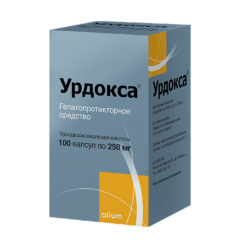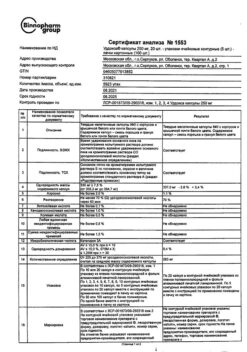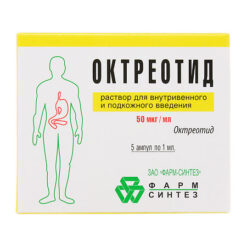No products in the cart.
Urdoxa 500,500 mg 50 pcs.
€42.82 €37.11
Description
Hepatoprotective agent.
ATX code: A05AA02
Pharmacological properties
Pharmacodynamics
Hepatoprotective agent, has a choleretic effect. It reduces the synthesis of cholesterol in the liver, its absorption in the intestine and its concentration in the bile, increases the solubility of cholesterol in the biliary system, stimulates the formation and excretion of bile. It decreases bile lithogenicity and increases bile acids content; it causes intensification of gastric and pancreatic secretion, increases lipase activity and has hypoglycemic effect. Causes partial or complete dissolution of cholesterol stones in enteral administration, reduces bile saturation with cholesterol, which promotes mobilization of cholesterol from gallstones. It has immunomodulatory effect, influences immunological reactions in the liver: it decreases the expression of some antigens on the membrane of hepatocytes, affects the number of T-lymphocytes, interleukin-2 formation, decreases the number of eosinophils.
Mucoviscidosis (Cystic Fibrosis)
According to clinical reports, there is long-term experience (up to 10 years and more) of treatment with ursodeoxycholic acid in children with hepatobiliary disease associated with cystic fibrosis. There is evidence that therapy with ursodeoxycholic acid is able to reduce the proliferation of bile ducts, slow down the development of lesions detected by histological examination, and even contribute to the reversal of hepatobiliary changes in the case if the therapy is started at early stages of cystic fibrosis. In order to optimize the effectiveness of treatment ursodeoxycholic acid therapy should be started as early as possible after the diagnosis of cystic fibrosis has been made.
Pharmacokinetics
. After oral administration, ursodeoxycholic acid is rapidly absorbed in the jejunum and in the proximal ileum by passive diffusion and in the distal ileum by active transport. About 60-80% is absorbed. After absorption, bile acid almost completely conjugates in the liver with glycine and taurine and is excreted with bile. During the first passage through the liver it is metabolized up to 60%.
Depending on the daily dose, type of disease or liver condition, more or less ursodeoxycholic acid accumulates in the bile. At the same time, there is a relative decrease in other more lipophilic bile acids.
In the action of intestinal bacteria ursodeoxycholic acid is partially broken down to form 7-keto-lithocholic and lithocholic acids. Lithocholic acid is hepatotoxic, in some animal species it causes damage to the liver parenchyma. In humans, it is absorbed only in small amounts, sulfated in the liver and thus detoxified before being excreted into the bile and excreted through the intestine. The half-life of ursodeoxycholic acid is 3.5-5.8 days.
Indications
Indications
Active ingredient
Active ingredient
Composition
Composition
1 tablet contains:
the active ingredient: ursodeoxycholic acid 500 mg;
excipients: microcrystalline cellulose, colloidal silica (aerosil), povidone K-30, polysorbate 80 (tween 80), crosspovidone, talc, magnesium stearate;
coating excipients: Hypromellose (hydroxypropyl methylcellulose), macrogol 6000 (polyethylene glycol 6000), talc.
How to take, the dosage
How to take, the dosage
For patients who are unable to swallow the drug Urdoxa® 500, film-coated tablets 500 mg, or with a body weight less than 47 kg, it is recommended to use ursodeoxycholic acid in capsules or suspension.
The tablets should be taken without chewing, with fluids. They should be taken regularly.
Dissolving cholesterol gallstones
The recommended dose is 10 mg ursodeoxycholic acid per 1 kg body weight per day, which corresponds to:
up to 60 kg
1 tablet
61-80 kg
1½ tablets
81-100 kg
2 tablets
over 100kg
2½ tablets
It usually takes 6-24 months to dissolve gallstones. If the size of the stones does not decrease after 12 months of treatment, treatment should be stopped.
The effectiveness of treatment should be evaluated every 6 months with ultrasound or X-rays. In an interim evaluation, it should be assessed whether calculi have calcified during this period. If stones have calcified, treatment should be stopped.
Treatment of biliary reflux gastritis
Take 250 mg (½ tablet) daily in the evening before bedtime.
The course of treatment from 10-14 days to 6 months, if necessary up to 2 years.
Symptomatic treatment of primary biliary cirrhosis
The daily dose depends on body weight and varies from 11/2 to 31/2 tablets
(14 ± 2 mg ursodeoxycholic acid per 1 kg of body weight).
In the first 3 months of treatment, the daily dose should be divided into several doses. After improvement of liver functional parameters, it is possible to switch to a single daily dose in the evening.
Body weight (kg)
Daily dose (mg/kg)
Urdoxa® 500, film-coated tablets, 500 mg
First 3 months
following.
morning
afternoon
evening
evening (single appointment)
47-62
12-16
1/2
In patients with primary biliary cirrhosis, in rare cases, clinical symptoms may worsen at the start of treatment, for example, itching may increase. In this case, treatment should be continued with ½ tablet daily, then the dose should be gradually increased (increasing the daily dose weekly by ½ tablet) until the recommended dosing regimen is achieved again.
Symptomatic treatment of chronic hepatitis of different genesis
The daily dose is 10-15 mg/kg in 2-3 doses. Duration of treatment is 6-12 months or more.
Primary sclerosing cholangitis
The daily dose is 12-15 mg/kg; if necessary, the dose may be increased to 20 mg/kg
in 2-3 doses. The duration of therapy ranges from 6 months to several years.
Mucoviscidosis (as part of complex therapy)
The daily dose is 20 mg/kg/day in 2-3 doses, with further increase to 30 mg/kg/day if necessary.
Body weight (kg)
Daily dose (mg/kg body weight)
Urdoxa® 500, film-coated tablets, 500 mg
morning
afternoon
evening
20 –
30 – 39
19 – 25
1/2
1/2
40 – 49
20 – 25
1/2
1/2
1
50 – 59
21 – 25
1/2
1
1
60 – 69
22 – 25
1
1
1
70 – 79
22 – 25
1
1
1 1/2
80 – 89
22 – 25
1
1 1/2
1 1/2
90 99- 99
23 – 25
1 1/2
1 1/2
1 1/2
100 – 109
23 – 25
1 1/2
1 1/2
2
>110
1 1/2
2
2
Non-alcoholic steatohepatitis
The average daily dose is 10-15 mg/kg in 2-3 doses. The duration of therapy is
6-12 months or more.
Alcoholic liver disease
The average daily dose is 10-15 mg/kg in 2-3 doses. The duration of therapy is
6-12 months or more.
Dyskinesia of the biliary tract
The average daily dose is 10 mg/kg in 2 doses for 2 weeks to 2 months. If necessary, it is recommended to repeat the course of treatment.
Interaction
Interaction
Colestyramine, colestipol and antacids containing aluminum hydroxide or smectite (aluminum oxide) reduce absorption of ursodeoxycholic acid in the intestine and thus reduce its absorption and effectiveness. If the use of preparations containing at least one of these substances is still necessary, they should be taken at least 2 h before taking Urdoxa® 500.
Ursodeoxycholic acid may enhance intestinal absorption of cyclosporine. Therefore, in patients simultaneously taking cyclosporine, it is necessary to determine cyclosporine blood concentrations and, if necessary, adjust the dose of cyclosporine.
Ursodeoxycholic acid may decrease absorption of ciprofloxacin.
In a clinical study involving healthy volunteers, concomitant use of ursodeoxycholic acid (500 mg/day) and rosuvastatin (20 mg/day) resulted in a slight increase in plasma concentrations of rosuvastatin. The clinical significance of this interaction, including for other statins, is unknown.
Ursodeoxycholic acid has been shown to decrease the maximum concentration and the area under the pharmacokinetic concentration-time curve of the calcium antagonist nitrendipine. In addition, a decrease in the therapeutic effect of dapsone has been reported.
These data, as well as in vitro data, suggest that ursodeoxycholic acid may induce CYP3A isoenzymes. However, the results of controlled clinical studies suggest that ursodeoxycholic acid has no pronounced inducing effect on CYP3A isoenzyme.
Estrogens, hypolipidemic drugs such as clofibrate increase bile cholesterol saturation and may decrease the litholytic effect of ursodeoxycholic acid.
Special Instructions
Special Instructions
The administration of the drug Urdoxa® 500 should be under the supervision of a physician. During the first 3 months of treatment, liver function parameters (transaminases, alkaline phosphatase and gammaglutamyl transpeptidase) in serum every 4 weeks, and then every 3 months. Monitoring of these parameters allows early detection of liver dysfunction. This also applies to patients in the later stages of primary biliary cirrhosis. In addition, this may quickly determine if a patient with primary biliary cirrhosis is responding to treatment.
When used in patients to dissolve cholesterol gallstones:
In order to assess treatment progress and for timely detection of signs of stone calcinosis depending on stone size, the gallbladder should be imaged (oral cholecystography) with obscuration examination in standing and supine positions (ultrasound) 6-10 months after starting treatment.
If the gallbladder cannot be visualized on X-rays or in cases of calcification of stones, poor gallbladder contractility or frequent attacks of colic, Urdox® 500 should not be used.
In the treatment of patients in the advanced stages of primary biliary cirrhosis:
In extremely rare cases of decompensation of liver cirrhosis have been reported. After discontinuation of therapy, regression of decompensation manifestations was noted.
In patients with primary biliary cirrhosis in rare cases at the beginning of treatment it is possible to increase clinical symptoms, for example, itching may intensify. In this case, the dose of ursodeoxycholic acid should be reduced, and then gradually increased again.
When used in patients with primary sclerosing cholangitis:
Long-term therapy with high doses of ursodeoxycholic acid (28-30 mg/kg/day) in patients with this pathology may cause serious side effects.
In patients with diarrhea, the drug dosage should be reduced. Treatment should be discontinued in persistent diarrhea.
Women of childbearing age can take the drug only if they use reliable contraception. It is recommended to use non-hormonal contraceptives, or oral contraceptives with low content of estrogen, because hormonal oral contraceptives may increase gallstone formation. Possible pregnancy should be ruled out before starting treatment.
Influence on the ability to drive and operate vehicles No effect on the ability to operate vehicles and moving machinery has been identified.
Synopsis
Synopsis
Contraindications
Contraindications
Radiopositive (with high calcium content) gallstones; impaired gallbladder contractility; acute inflammatory diseases of the gallbladder and bile ducts; Biliary tract occlusion (occlusion of common bile or vesicular ducts); frequent episodes of biliary colic; hypersensitivity to the components of the drug or bile acids; children under 3 years of age (for this dosage form); decompensated cirrhosis and significant hepatic and/or renal insufficiency.
Pediatric population
Failed portoenterostomy or cases of failure to restore normal bile flow in children with biliary atresia.
In children under 3 years of age, and in patients with difficulty swallowing tablets, ursodeoxycholic acid in suspension is recommended.
Side effects
Side effects
Evaluation of adverse events is based on the following classification:
Very frequent (â¥1/10)
Frequent (â¥1/100 – <1/10)
Infrequent (â¥1/1000 – <1/100)
Rare (â¥1/10000 – <1/1000)
Very rare (<1/10000).
Gastrointestinal tract disorders:
In clinical studies, loose stools or diarrhea were frequently observed during treatment with ursodeoxycholic acid.
When treating primary biliary cirrhosis, acute right upper abdominal pain was very rarely observed.
Liver and biliary tract disorders:
In very rare cases, calcification of gallstones may occur during treatment with ursodeoxycholic acid.
When treating advanced stages of primary biliary cirrhosis, in very rare cases, decompensation of liver cirrhosis has been observed, which regresses after discontinuation of the drug.
Skin and subcutaneous tissue disorders:
In very rare cases, allergic reactions, including urticaria, may be observed.
If any of the side effects listed in the instructions worsen, or if you notice other side effects not listed in the instructions, please tell your doctor.
Overdose
Overdose
In case of overdose, diarrhea is possible. In general, other symptoms of overdose are unlikely, since with increasing dose of ursodeoxycholic acid its absorption decreases, and excretion in the feces increases.
The specific treatment is not required. The consequences of diarrhea are treated symptomatically (restoration of water-electrolyte balance).
Pregnancy use
Pregnancy use
According to animal studies, ursodeoxycholic acid has no effect on fertility. There are no data on the effect of treatment with ursodeoxycholic acid on fertility in humans.
Pregnancy
The data on the use of ursodeoxycholic acid in pregnant women are limited or absent. Animal studies have shown reproductive toxicity in early pregnancy. During pregnancy, Urdoxa® 500 should not be used unless clearly necessary.
Fertility
The use of the drug by women of childbearing potential is possible only if they use reliable contraceptive methods.
The use of non-hormonal contraceptives or low-estrogen oral contraceptives is recommended, because hormonal oral contraceptives may increase gallstone formation. Possible pregnancy should be ruled out before starting treatment.
Breastfeeding
According to several documented cases, the level of ursodeoxycholic acid in breast milk in women is very low, and therefore no adverse reactions in children while breastfeeding are expected.
Similarities
Similarities
Additional information
| Shelf life | 3 years. Do not use after the expiration date. |
|---|---|
| Conditions of storage | At a temperature not exceeding 25 oC. Keep out of reach of children. |
| Manufacturer | Alium JSC, Russia |
| Medication form | pills |
| Brand | Alium JSC |
Other forms…
Related products
Buy Urdoxa 500,500 mg 50 pcs. with delivery to USA, UK, Europe and over 120 other countries.











